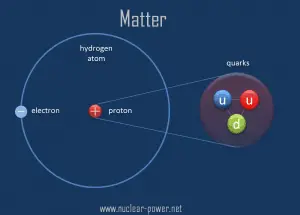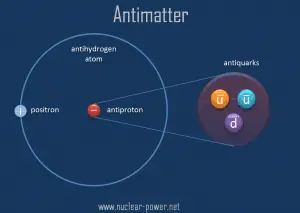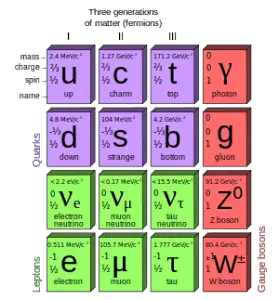 The hadrons are further sub-divided into baryons and mesons according to the number of quarks they contain. Protons and neutrons each contain three quarks; they belong to the family of particles called the baryons. Other baryons are the lambda, sigma, xi, and omega particles. On the other hand, mesons bosons are composed of two quarks: a quark and an antiquark. Besides charge and spin (1/2 for the baryons), two other quantum numbers are assigned to these particles: baryon number (B) and strangeness (S). Baryons have a baryon number, B, of 1, while their antiparticles, called antibaryons, have a baryon number of −1. A nucleus of deuterium (deuteron), for example, contains one proton and one neutron (each with a baryon number of 1) and has a baryon number of 2.
The hadrons are further sub-divided into baryons and mesons according to the number of quarks they contain. Protons and neutrons each contain three quarks; they belong to the family of particles called the baryons. Other baryons are the lambda, sigma, xi, and omega particles. On the other hand, mesons bosons are composed of two quarks: a quark and an antiquark. Besides charge and spin (1/2 for the baryons), two other quantum numbers are assigned to these particles: baryon number (B) and strangeness (S). Baryons have a baryon number, B, of 1, while their antiparticles, called antibaryons, have a baryon number of −1. A nucleus of deuterium (deuteron), for example, contains one proton and one neutron (each with a baryon number of 1) and has a baryon number of 2.
Electric Charge of Quarks
The most familiar baryons are the proton and neutron, each constructed from up and down quarks.
The proton has a quark composition of uud, and so its charge quantum number is:
q(uud) = 2/3 + 2/3 + (-1/3) = +1
The neutron has a quark composition of udd, and its charge quantum number is therefore:
q(udd) = 2/3 + (-1/3) + (-1/3) = 0
Since the neutron has no net electric charge, it is not affected by electric forces, but the neutron does have a slight distribution of electric charge within it. This is caused by its internal quark structure, and this results in the non-zero magnetic moment (dipole moment) of the neutron. Therefore the neutron also interacts via electromagnetic interaction but is weaker than the proton.
Mass of Quark
The mass of the neutron is 939.565 MeV/c2, whereas the mass of the three quarks is only about 10 MeV/c2 (only about 1% of the mass-energy of the neutron). Like the proton, most of the mass (energy) of the neutron is in the form of the strong nuclear force energy (gluons). The quarks of the neutron are held together by gluons, the exchange particles for the strong nuclear force. Gluons carry the color charge of a strong nuclear force.
Therefore, we have to distinguish between current quark mass (also called the mass of the ‘naked’ quarks) and constituent quark mass. Current quark mass refers to the mass of a quark by itself, while constituent quark mass refers to the current quark mass plus the mass of the gluon particle field surrounding the quark.
Noteworthy, because most of your mass is due to the protons and neutrons in your body, your mass (and therefore your weight on a bathroom scale) comes primarily from the gluons that bind the constituent quarks together rather than from the quarks themselves. Mass is primarily a measure of the energies of the quark motion and the quark-binding fields of any real object. It must be noted that gluons are inherently massless and possess energy.
Antiquarks
 In particle physics, corresponding to most kinds of particles, there is an associated antiparticle. An antiparticle has the same mass and opposite charge (including an electric charge). For example, there is a corresponding type of antiparticle for every quark. The antiquarks have the same mass, mean lifetime, and spin as their respective quarks, but the electric charge and other charges have the opposite sign. Up-type antiquarks have charges of −2⁄3 e, and down-type antiquarks have charges of +1⁄3 e. Since the electric charge of a hadron is the sum of the charges of the constituent quarks, all hadrons have integer charges.
In particle physics, corresponding to most kinds of particles, there is an associated antiparticle. An antiparticle has the same mass and opposite charge (including an electric charge). For example, there is a corresponding type of antiparticle for every quark. The antiquarks have the same mass, mean lifetime, and spin as their respective quarks, but the electric charge and other charges have the opposite sign. Up-type antiquarks have charges of −2⁄3 e, and down-type antiquarks have charges of +1⁄3 e. Since the electric charge of a hadron is the sum of the charges of the constituent quarks, all hadrons have integer charges.
Quarks in the Standard Model
 Quarks and electrons are some of the elementary particles. Many fundamental particles have been discovered in various experiments. So many that researchers had to organize them, just like Mendeleev did with his periodic table. This is summarized in a theoretical model (concerning the electromagnetic, weak, and strong nuclear interactions) called the Standard Model. In particle physics, an elementary particle or fundamental particle is a particle whose substructure is unknown. Thus it is unknown whether it is composed of other particles.
Quarks and electrons are some of the elementary particles. Many fundamental particles have been discovered in various experiments. So many that researchers had to organize them, just like Mendeleev did with his periodic table. This is summarized in a theoretical model (concerning the electromagnetic, weak, and strong nuclear interactions) called the Standard Model. In particle physics, an elementary particle or fundamental particle is a particle whose substructure is unknown. Thus it is unknown whether it is composed of other particles.
There are six “flavors” of quarks six quarks in the present Standard Model, just as there are six leptons based on a presumed symmetry in nature. The three quarks originally proposed and accepted were labeled u (up quark), d (down quark), and s (strange quark). The other three quarks are called charmed, bottom, and top. They can successfully account for all known mesons and baryons. The most familiar baryons are the proton and neutron, each constructed from up and down quarks.